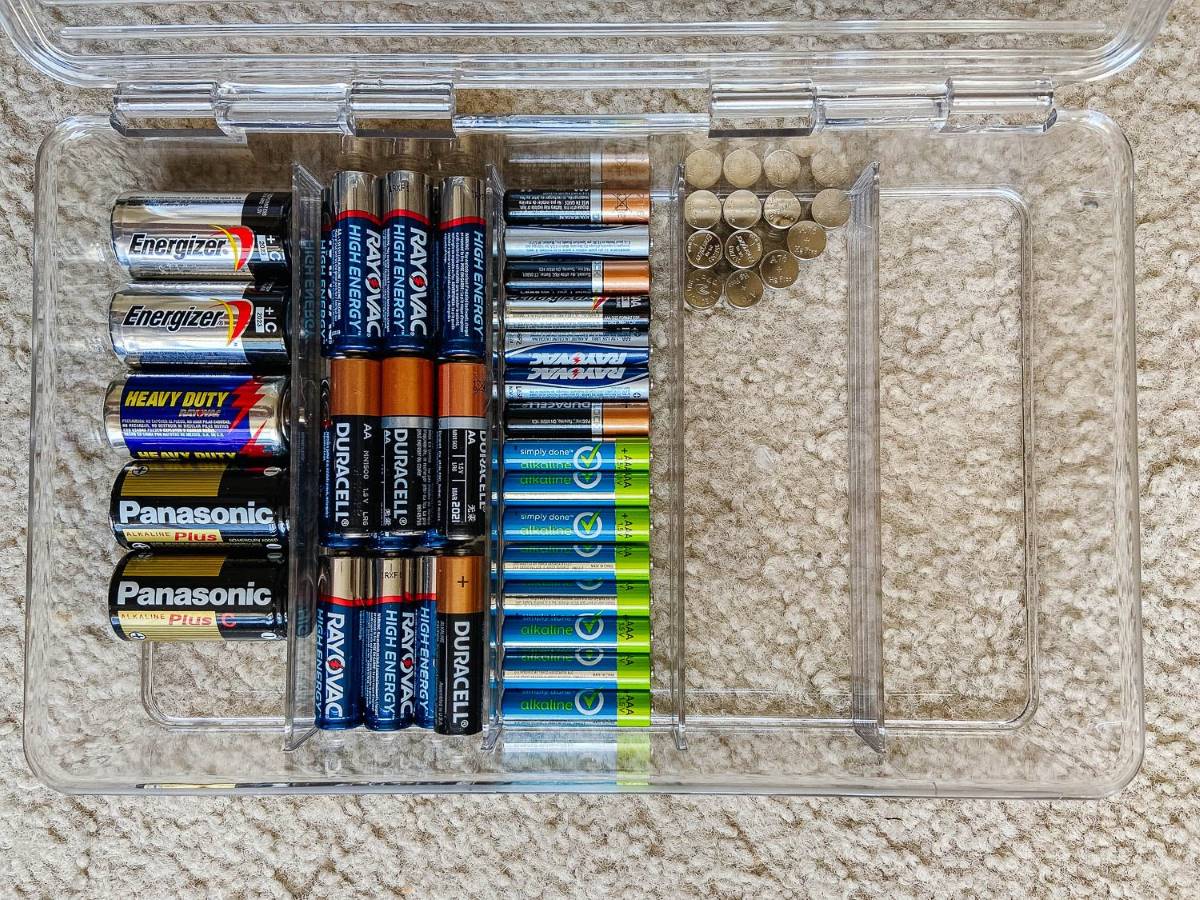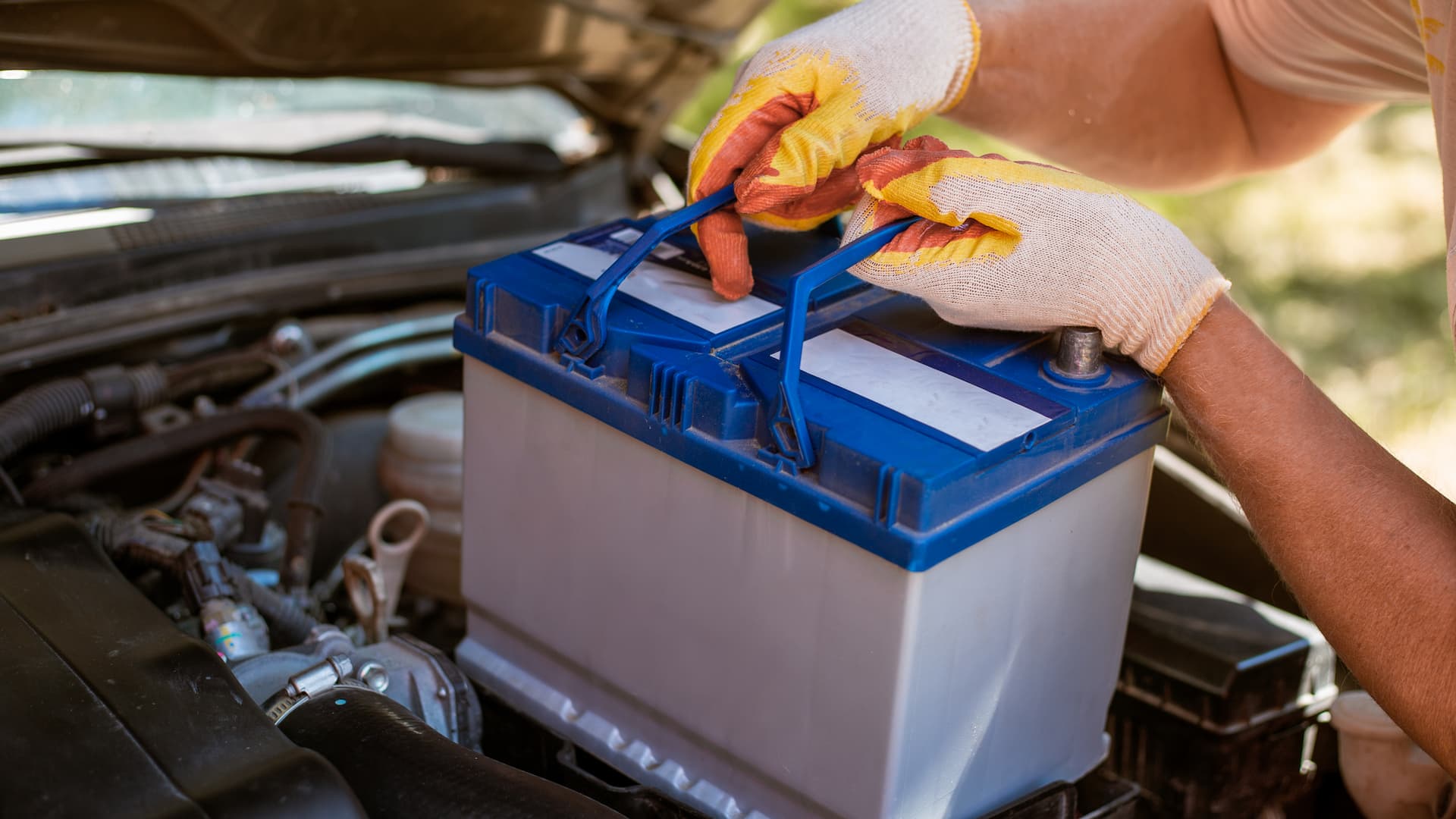

Articles
How To Store Dead Batteries
Modified: January 19, 2024
Looking for articles on how to store dead batteries? Find expert tips and guidelines for safely storing batteries to prolong their lifespan.
(Many of the links in this article redirect to a specific reviewed product. Your purchase of these products through affiliate links helps to generate commission for Storables.com, at no extra cost. Learn more)
Introduction
Batteries are an essential part of our daily lives. From powering our smartphones and laptops to keeping our cars running, batteries play a vital role in our modern world. However, what happens when your batteries die? While it may be tempting to throw them in the trash, it’s important to know that improper disposal of dead batteries can have harmful effects on the environment. In this article, we will explore the importance of properly storing dead batteries and provide you with some methods to do so safely.
Why should you store dead batteries, you may ask? Well, the main reason is to prevent any accidental leakage or damage from occurring. Dead batteries can still contain some residual charge, and if not stored properly, they can leak corrosive chemicals or even explode, posing a potential safety hazard. Additionally, by storing dead batteries, you can ensure that they are properly disposed of or recycled, minimizing their impact on the environment.
Before we delve into the various methods of storing dead batteries, it’s crucial to understand some safety precautions. Always handle dead batteries with care, making sure to wear protective gloves and eyewear to minimize any potential risks. Keep them away from flammable materials, children, and pets. It’s also important to store them in a cool and dry place, away from direct sunlight or extreme temperatures.
Now that we understand the importance of storing dead batteries and the necessary safety precautions, let’s take a look at the materials you’ll need to effectively store them.
Key Takeaways:
- Properly storing dead batteries is crucial for safety, environmental protection, and compliance with local regulations. It involves sorting, labeling, and securing batteries at home or in outdoor locations, with the ultimate goal of recycling for sustainable reuse.
- By following safety precautions and utilizing suitable storage containers, dead batteries can be stored safely at home or outside. Recycling dead batteries is the most responsible option, contributing to environmental conservation and the reuse of valuable materials.
Read more: How To Fix Dead Ryobi 18V Battery
Why Should You Store Dead Batteries?
Storing dead batteries may seem like a hassle, but it’s crucial for several important reasons. Let’s explore why you should take the time to properly store your dead batteries:
- Prevent Leakage and Damage: Dead batteries can still contain small amounts of residual charge. If not stored properly, this residual charge can cause the batteries to leak corrosive chemicals. This can lead to damage to your belongings, such as electronics or appliances. Storing dead batteries in a safe manner helps prevent leakage and potential damage.
- Ensure Safety: While dead batteries may not have enough charge to power devices, they can still pose a safety hazard. If mishandled or stored improperly, dead batteries can potentially explode or catch fire. By storing them correctly, you significantly minimize the risk of accidental ignition or injury.
- Protect the Environment: Improper disposal of dead batteries can have detrimental effects on the environment. Batteries contain toxic substances such as mercury, lead, cadmium, and corrosive acids. When thrown in regular trash, these chemicals can seep into the soil or water, contaminating the environment and potentially harming wildlife. Storing dead batteries allows for proper disposal or recycling, minimizing their impact on the ecosystem.
- Comply with Local Regulations: In many regions, there are specific regulations in place regarding battery disposal. Storing dead batteries allows you to comply with these regulations and ensure that they are disposed of or recycled in the appropriate manner. This contributes to a cleaner and safer community.
- Potential for Recycling: Dead batteries can often be recycled to extract valuable materials, such as metal components. By storing them separately from other waste, you make it easier to identify and collect them for recycling purposes. Recycling batteries not only conserves resources but also reduces the need for new battery production, which has its own environmental impacts.
Now that we understand the importance of storing dead batteries, let’s dive into the different methods you can use to store them safely.
Safety Precautions
When it comes to storing dead batteries, it’s crucial to prioritize safety to prevent accidents and minimize any potential risks. Here are some important safety precautions to keep in mind:
- Wear Protective Gear: Always wear protective gloves and eyewear when handling dead batteries. This will protect you from any possible chemical leakage or exposure.
- Avoid Contact with Skin or Eyes: Dead batteries can contain corrosive chemicals, so it’s important to avoid direct contact with your skin or eyes. In case of accidental contact, rinse the affected area thoroughly with water and seek medical attention if necessary.
- Keep Away from Flammable Materials: Dead batteries should be stored in an area away from flammable materials, such as paper, fabric, or gasoline. This reduces the risk of fire or explosions in the event of leakage or accidental short-circuiting.
- Store in a Cool and Dry Place: Choose a storage location that is cool, dry, and well-ventilated. High temperatures can accelerate the chemical reactions inside the batteries, increasing the risk of leakage or explosion. Avoid exposing dead batteries to direct sunlight or extreme temperatures.
- Keep Out of Reach of Children and Pets: Dead batteries may appear harmless, but they can still pose a danger to curious children or pets. Store them in a secure location that is inaccessible to little hands or paws.
- Separate Different Types of Batteries: If you are storing different types of batteries, such as alkaline, lithium-ion, or rechargeable batteries, it’s important to keep them separate. Some battery chemistries can react with each other and cause damage or overheating.
- Use Proper Battery Storage Containers: Consider using specialized battery storage containers or cases to store dead batteries. These containers are designed to prevent leakage and protect the environment from any potential chemical spills.
- Dispose of Damaged Batteries Immediately: If you come across any damaged or swollen batteries, do not attempt to store them. These batteries can be unstable and should be disposed of immediately following proper disposal guidelines for hazardous waste.
By following these safety precautions, you can ensure that the process of storing dead batteries is safe, secure, and environmentally responsible. Now, let’s move on to discussing the materials you’ll need for storing dead batteries effectively.
Materials Needed
Before you start storing your dead batteries, it’s important to gather the necessary materials to ensure a secure and organized storage system. Here are the materials you will need:
- Storage Containers: Select appropriate storage containers to keep your dead batteries. Look for containers that are leak-proof, durable, and preferably made of non-conductive material such as plastic. You can choose between small plastic boxes with lids or specialized battery storage cases available in various sizes.
- Compartments or Dividers: To further organize your storage containers, consider using compartments or dividers. These can help separate different types and sizes of batteries, making it easier to locate and manage them.
- Labeling Materials: Labeling your storage containers is essential for easy identification. Use adhesive labels or markers to clearly mark the containers, indicating the type of batteries stored and other relevant information, such as the date of storage.
- Protective Gloves and Eyewear: As mentioned earlier, it’s important to prioritize safety when handling dead batteries. Wear protective gloves and eyewear to protect yourself from any potential chemical leakage or exposure.
- Secure Lid or Cover: Ensure that your storage containers have a secure lid or cover to prevent accidental spills or exposure to moisture. This will help maintain the integrity of the stored batteries and keep them in a safe condition.
- Storage Location: Decide on a suitable storage location for your dead batteries. Choose a cool, dry, and well-ventilated area away from direct sunlight, extreme temperatures, and flammable materials.
- Recycling Resources: If your intention is to eventually dispose of or recycle the dead batteries, gather information on local recycling programs or facilities in your area. This will help you understand the proper disposal procedures and ensure that your dead batteries are recycled responsibly.
By having these materials ready, you’ll be well-prepared to store your dead batteries safely and efficiently. Now, let’s explore the different methods you can utilize for storing your dead batteries, whether at home or other locations.
Store dead batteries in a cool, dry place at room temperature. Avoid extreme heat or cold, as it can affect the battery’s performance. Keep them in a plastic or cardboard container to prevent contact with metal objects.
Method 1: Storing Dead Batteries at Home
Storing dead batteries at home is a convenient option that allows you to keep them in a safe and organized manner until they can be properly disposed of or recycled. Follow these steps to store your dead batteries at home:
- Sort and Separate: Begin by sorting through your dead batteries and separating them by type and size. This will make it easier to organize and locate specific batteries when needed.
- Prepare Storage Containers: Take your selected storage containers and ensure they are clean and dry. If using a plastic box with a lid, consider lining it with a soft material such as felt or foam to prevent batteries from moving around and potentially contacting each other.
- Organize Batteries: Place the sorted batteries in the storage containers, keeping similar types together. If you have compartments or dividers, use them to separate different sizes and prevent contact between the batteries to avoid any chance of short-circuits.
- Label the Containers: Use adhesive labels or markers to clearly label each container, indicating the type of batteries stored inside. This will help you quickly identify and locate specific batteries when needed.
- Secure the Containers: Make sure the lids or covers of the storage containers are securely closed to prevent any accidental spills or exposure to moisture. This will maintain the condition of the batteries and help prolong their shelf life.
- Choose an Ideal Storage Location: Find a suitable storage location in your home for the containers of dead batteries. Avoid areas with direct sunlight, extreme temperatures, or high humidity. A well-ventilated room or a designated shelf in a cool and dry basement can be an ideal option.
- Regularly Inspect and Dispose: Periodically check the stored batteries for any signs of leakage, corrosion, or damage. If you come across any damaged batteries, follow the proper disposal guidelines for hazardous waste in your area to ensure their safe disposal and minimize environmental impact.
- Research Local Recycling Options: While storing dead batteries at home can provide a temporary solution, it’s important to research local recycling options. Look for battery recycling programs or facilities near you to properly dispose of and recycle the dead batteries in an environmentally sustainable manner.
By following this method, you can efficiently store your dead batteries at home while maintaining safety and promoting responsible waste management. Let’s move on to the next method, which involves storing dead batteries outside the home.
Read more: How To Store Dead Flowers
Method 2: Storing Dead Batteries Outside
If you prefer to store dead batteries outside your home, there are a few additional considerations to keep in mind. Follow these steps to safely store dead batteries outside:
- Choose a Suitable Outdoor Location: Look for an outdoor area that is dry, well-ventilated, and away from direct sunlight or extreme weather conditions. Consider using a covered storage container or shed to provide extra protection against moisture and temperature fluctuations.
- Protect from Environmental Elements: Ensure that the storage container or shed is waterproof and can withstand the outdoor elements. This will help prevent any potential damage to the batteries caused by rain, snow, or excessive humidity.
- Prepare Storage Containers: Use the same types of storage containers mentioned in Method 1. Ensure they are clean, dry, and suitable for outdoor use. Consider placing a moisture-absorbing packet or desiccant inside the container to help minimize moisture buildup.
- Organize and Label Batteries: Sort the dead batteries by type and size, as well as any other relevant details. Place them in separate compartments or dividers within the storage containers to keep them organized and prevent contact between different types of batteries.
- Secure the Storage Containers: Make sure the lids or covers of the storage containers are tightly closed to protect the batteries from moisture and other outdoor elements. This will help maintain the integrity of the batteries while they are stored outside.
- Implement Secure Storage Measures: If storing batteries outside poses a security concern, consider taking extra measures to secure the storage containers. This can include using a lock or securing them to a fixed object to discourage unauthorized access.
- Regularly Monitor and Inspect: Regularly check the stored batteries for any signs of leakage, corrosion, or damage. If you notice any issues, handle them using proper safety precautions and dispose of them following local hazardous waste disposal guidelines.
- Research Local Recycling Programs: As with Method 1, be sure to research local recycling programs that accept dead batteries. Even if you store dead batteries outside, it is important to dispose of them properly to minimize environmental impact.
By following these steps, you can safely store dead batteries outside your home, providing a dedicated space for their proper storage until they can be disposed of or recycled. Now, let’s explore the third method, which involves recycling dead batteries.
Method 3: Recycling Dead Batteries
One of the most responsible and environmentally-friendly options for disposing of dead batteries is recycling. Recycling dead batteries ensures that valuable materials are recovered and reused, while hazardous components are handled appropriately. Here’s a step-by-step guide on how to recycle dead batteries:
- Research Local Recycling Programs: Look for recycling programs or facilities in your area that accept batteries for recycling. Check with your local government, waste management companies, or electronics retailers for information on drop-off locations or collection events specific to battery recycling.
- Sort and Separate: Sort your dead batteries by type, such as alkaline, lithium-ion, or rechargeable batteries. Some recycling programs may have specific requirements for different battery types, so it’s important to separate them accordingly.
- Prepare Batteries for Recycling: Before recycling, it’s important to prepare the batteries properly. Tape the terminals of each battery with non-conductive tape or place them in separate plastic bags to prevent any accidental contact and potential short-circuiting.
- Packaging and Transport: Follow the guidelines provided by the recycling program or facility for packaging and transportation. Some programs may require individual bagging or placing batteries in sealed containers for safe transport to the collection point.
- Drop-off or Collection: Take your prepared dead batteries to the designated drop-off location or participate in a battery collection event, following the instructions provided by the recycling program. Be sure to ask any questions you may have regarding the acceptance of specific battery types or any additional requirements.
- Keep Updated on Regulations: Stay informed about any changes in local battery recycling regulations and guidelines, as they may evolve over time. Ensure that you are aware of any specific restrictions or safety measures when it comes to recycling dead batteries in your area.
- Encourage Others to Recycle: Spread awareness about the importance of battery recycling to your friends, family, and community. Encourage them to recycle their dead batteries as well, further reducing environmental impact.
By following these steps, you can ensure that your dead batteries are properly recycled, minimizing their impact on the environment and contributing to the sustainable reuse of valuable materials. Let’s conclude our discussion on storing dead batteries.
Conclusion
Properly storing dead batteries is not only crucial for safety but also essential for minimizing environmental impact. By following the methods outlined in this article, you can ensure that your dead batteries are stored safely and responsibly until they can be disposed of or recycled.
Remember, storing dead batteries at home involves sorting and organizing them in suitable storage containers, labeling them for easy identification, and choosing a proper storage location. Taking precautions such as wearing protective gear, keeping batteries away from flammable materials, and regularly inspecting them are also important.
If you prefer to store dead batteries outside, find a suitable outdoor location that is dry and well-ventilated. Ensure you provide proper protection from environmental elements, secure the storage containers, and follow the same safety guidelines mentioned for home storage.
However, the ultimate goal should be to recycle dead batteries whenever possible. Research local recycling programs, separate batteries by type, and properly prepare them for recycling. Transport them to designated drop-off locations or participate in battery collection events to ensure they are recycled in an environmentally responsible manner.
By following these methods, you can play your part in reducing hazardous waste and conserving valuable resources. Remember, even though dead batteries may no longer serve their intended purpose, they can still have a significant impact if not handled properly.
Take the extra step to store dead batteries safely and responsibly, and encourage others to do the same. Together, we can make a positive impact on the environment and create a sustainable future.
Frequently Asked Questions about How To Store Dead Batteries
Was this page helpful?
At Storables.com, we guarantee accurate and reliable information. Our content, validated by Expert Board Contributors, is crafted following stringent Editorial Policies. We're committed to providing you with well-researched, expert-backed insights for all your informational needs.















0 thoughts on “How To Store Dead Batteries”